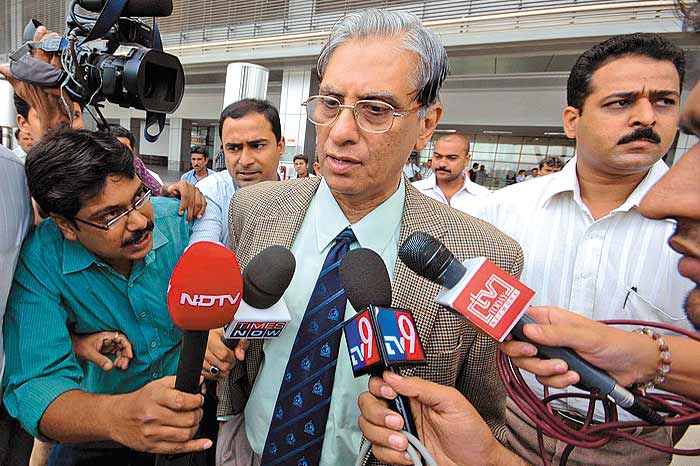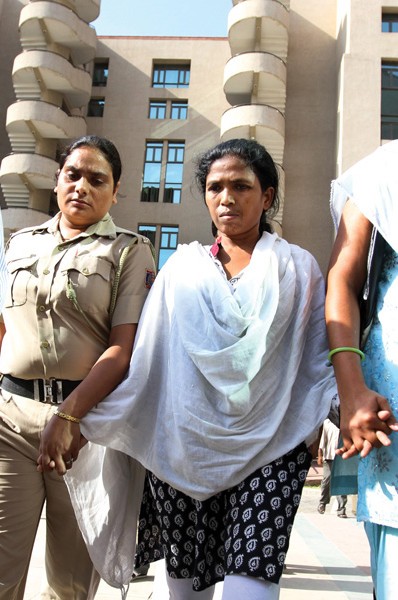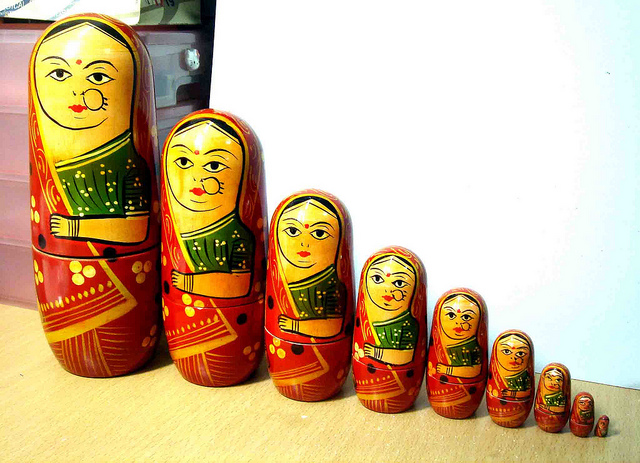
Crowds in support of Ambedkar
If the Ambedkar-conceived Constitution can be amended 97 times, can’t a textbook, which has to be treated as a work in progress, be amended?
When I was alerted to Shankar’s cartoon on April 10, it struck me like a whiplash. I am no teacher nor do I have children; textbooks are a distant memory. In the English medium textbooks I grew up on in Andhra Pradesh, caste, let alone Ambedkar, was rarely mentioned. Like most privileged Indians, I was to discover all this shamefully belatedly in life.
When a reporter called me for a "quote" on the cartoon row, I asked her if she even knew where Ambedkar was born. Silence. Our textbooks don’t tell students that Ambedkar, unlike Mahatma Gandhi, did not have to travel abroad to realise what it meant to be thrown out of a train; and that after having earned a PhD from Columbia University, he had to hide his identity to rent a room in an inn in Baroda and was kicked out when discovered. Dandi, yes – but neither teachers nor students are aware of the momentous, Ambedkar-led, civil rights struggle for water in Mahad in 1927. Most newspaper editors wouldn’t be able to name the four newspapers Ambedkar edited and published. Any small-town Dalit activist would know all this. Forget our MPs, the non-Dalit intellectual classes’ collective ignorance of Ambedkar seems pathological.
My concern over the cartoon in the NCERT Class XI political science textbook, Indian Constitution at Work, is how children and teachers in a classroom would read it in a society where caste prejudices and stereotypes are still rampant. Consider the general hostility towards Dalits and those from socially disadvantaged backgrounds entering elite English medium schools, as witnessed in the near racist opposition to the idea of including the poor (read "lower" castes) in rich people’s private schools through the Right to Education (RTE) Act. How would the largely non-Dalit teaching community (who handle NCERT textbooks in English) frame the cartoon? A year ago, the principal of Delhi’s elite Shri Ram School, Manika Sharma, was quoted in The Wall Street Journal as saying that she was "horrified" and "jolted" when the floor sweeper from her home enrolled her child in the school where Sharma is the principal. When saying, "I can’t sit across the table from someone who sweeps my floors," she was vocalising the fear of millions of well-off Indians who think the "outcastes" should only serve, stand and wait.
Now, how would Sharma or students trained by her read this cartoon? How would their reading potentially impact the self-confidence and self-worth of the 25 per cent – children of sweepers, shoemakers, drivers, dhobis and vegetable vendors – being coaxed into these elite bastions by the RTE Act? Suppose there was just the odd Dalit student in a classroom, what are the chances of her different reading of the Shankar cartoon getting a hearing from Sharma-type principals? She would likely be shouted down, just like voices from the Dalit movement are booed at by self-righteous upholders of "freedom of expression", a term as carelessly bandied as "merit" was to attack reservation.
A snail moves tardily and a rotund Ambedkar seems to be slowing it down further. Slowness is something "undeserving" "quota" students are routinely accused of. Ambedkar’s whip is limp while Nehru’s is taut – after all, the latter is the ramrod erect national patriarch. Ambedkar cuts a sorry figure. Yes, the chapter in question discusses Ambedkar’s crucial role several times yet stops short of mentioning how and why his favourite project, the Hindu Code Bill that gave women the rights to divorce and property, was scuttled both in the Constituent Assembly and later in Parliament. But can we expect one textbook to do everything?
Images and symbols tend to have a stronger impact than words. Almost every ‘conscientised’ Dalit has a picture of Ambedkar in his or her house, they are familiar with his trials and tribulations, and the more educated Dalits engage with his key works. Ambedkar is a rallying point, a symbol of hope, of possibilities of exit from the morass of caste. In contrast, finding a picture or work of Ambedkar in an average non-Dalit household would be as rare as finding beef cooked with asafoetida – unlike Dalits, the brahmanical classes have little to gain by embracing Ambedkar’s anti-caste ideas.
As recently as 2006, at the height of the media-fuelled anti-Mandal II mania, students at the All India Institute of Medical Sciences burnt Ambedkar’s books in the hostel corridor, made vulgar gestures, shot a video of this and circulated a CD among fellow students during their annual cultural festival. These arrogant and ignorant students would not long ago have been in Class XI or XII, taught by some Sharma.
Yes, political parties across party lines use this occasion to show a patently false love for Ambedkar and his iconic status but remain silent about the recent judgement in the 1996 Bathani Tola massacre of 21 Dalits, where all 23 accused were acquitted. But that shouldn’t rankle us much. We live in a country where justice for real crimes, like the 2006 Kherlanji carnage, is elusive, even structurally impossible; a country where it is easier to win retribution for the symbolic desecration of Ambedkar. And when Dalits are forced to take solace only in symbols, who is to be blamed?
What rankles is how liberal and even left intellectuals, who claim to be fellow-travellers of Dalits, have imposed moral pressure on Dalits and Dalit intellectuals to come out and stand in support of retaining the textbook in all its sanctity. Dalits have been portrayed both in big media and alternative media, such as the blog Kafila, as "emotional-devotional" fanatics who lose all "rationalism" – something non-Dalits gleefully point out Ambedkar stood for.
It is one thing for a news publication to feature such a cartoon and quite another for it to be reused in a textbook. What makes us think these cartoonists are beyond prejudices that the Dalit-free media they work for and the society they are part of are saturated with?
My friend and cartoonist at The Hindu, Surendra, had the tendency to show his "common man" seated, reading the newspaper or watching TV, and the woman of the house always serving tea or coffee, standing. He was unwittingly reinforcing gender stereotypes that RK Laxman and Shankar had perpetuated, stereotypes which, it could be argued, reflect reality. What if one such cartoon should find its way into textbooks? Should we not seek amends so that children are not fed stereotypes of gendered division of labour? It is one thing for a news publication to feature such a cartoon and quite another for it to be reused in a textbook. What makes us think these cartoonists are beyond prejudices that the Dalit-free media they work for and the society they are part of are saturated with?
This is just one part of the story. This debate has failed to engage with what the textbook actually sets out to do. On reading it, I realised it was radical in many ways. This is a textbook that uses the word Dalit several times unapologetically. This seems a first, given that as recently as 2008, the Haryana government ordered a ban on the use of the word Dalit interchangeably with scheduled caste in all official parlance.
Here is a passage from it that would have made Ambedkar proud: "As early as 1841, it was noticed that the Dalit people of northern India were not afraid to use the newly introduced legal system and bring suits against their landlords. So this new instrument of modern law was effectively adopted by the people to address questions of dignity and justice." In the last chapter, the textbook proffers another strong opinion: "Is it a coincidence that the central square of every other small town has a statue of Dr Ambedkar with a copy of the Indian Constitution? Far from being a mere symbolic tribute to him, this expresses the feeling among Dalits that the Constitution reflects many of their aspirations." But only Dalit aspirations?
In one scenario, the textbook makes students imagine that they receive a postcard from Hadibandhu, a "member of the Dalit community" in Puri district, Orissa. Men from this community refused to follow a custom that required them to wash the feet of the groom and guests of the "upper caste" during marriage ceremonies. In revenge, four women from this community are beaten up and another is paraded naked. The postcard writer says: "Our children are educated and they are not willing to do the customary job of washing the feet of upper-caste men, clear the leftovers after the marriage feast and wash the utensils." Then the critical pedagogical import is driven home: "Does this case involve violation of fundamental rights? What would you order the government to do in this case?"
The textbook also underscores the limitations of the first past the post (FPTP) electoral system. It says that though Muslims constitute 13.5 per cent of the population, the number of Muslim MPs in the Lok Sabha has usually been less than six per cent and that a similar situation prevails in most state assemblies. It explains proportional representation and sows doubt in the minds of the student readers: "The FPTP electoral system can mean that the dominant social groups and castes can win everywhere and the oppressed social groups may continue to remain unrepresented."
Who is to take credit for the radical language of this textbook? Of course, the Dalit movement and post-Mandal consolidation of OBC interests, which have created enough intellectual, social and political pressure to warrant these changes. The textbook ends with a "request for feedback" and asks readers to suggest "changes you would like to see in the next version of this book". We first need to acknowledge that neither the textbook nor Ambedkar is above criticism. An online petition called ‘In Defence of Critical Pedagogy’, signed by academic luminaries – mostly with upper-caste sounding surnames – seems to treat the textbook like a sacred text, as if it were the Bhagavad Gita that statues of Gandhi show him holding. If the Ambedkar-conceived Constitution can be amended 97 times in 62 years, can’t a textbook, which has to be treated as a work in progress, be amended?
Till such time, we can live with this textbook and celebrate its triumphs.
This article was published in The Indian Express on May 24, 2012; www.indianexpress.com
Archived from Communalism Combat, June 2012. Year 18, No.166 – Controversy.
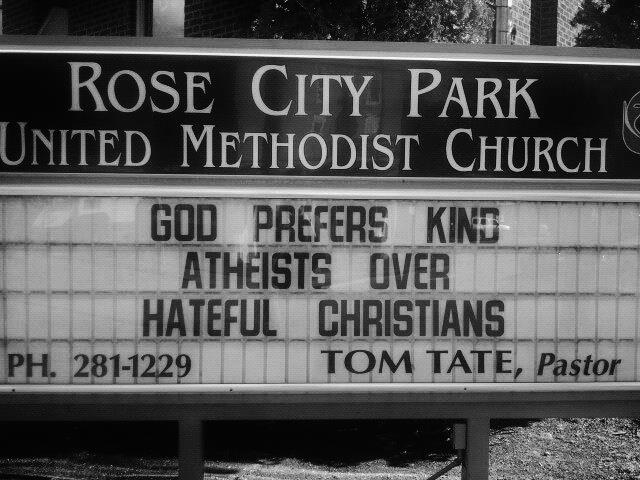

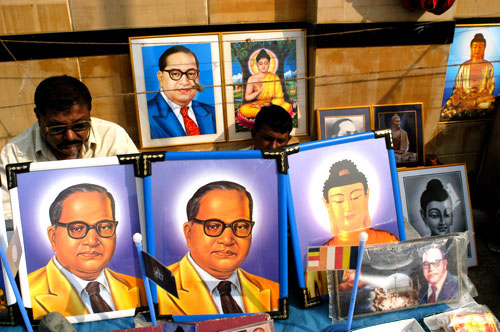

.png)
